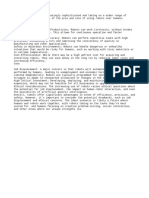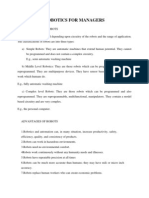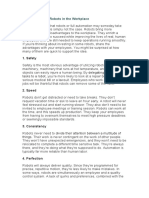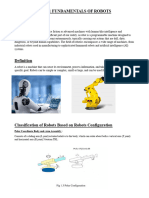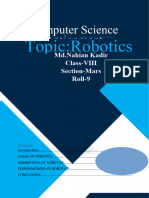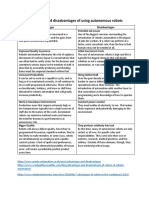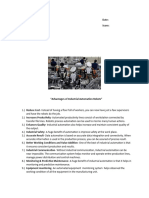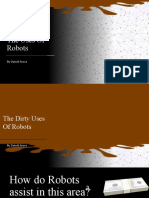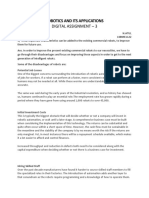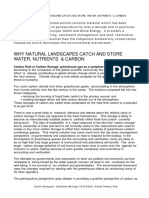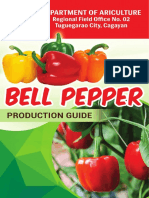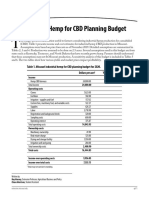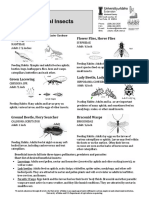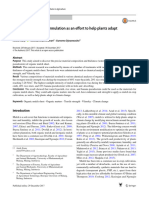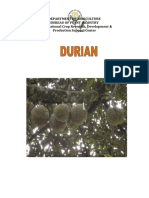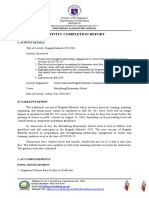Advantages and Disadvantages of Robots
Advantages and Disadvantages of Junk food
10 Agricultural techniques for water conservation
Conservation of Water
Advantages and Disadvantages of Robots
Advantages and Disadvantages of Robots-
Introduction
Imagine machines that can move, see, and do things independently without constant
human guidance – those are robots! They are like super-smart helpers that can
follow instructions to complete tasks.
Robots may look like humans, animals, or just moving parts. They can be small, like
tiny robots that help in surgeries, or big and strong, like those that help in factories
to build cars. Moreover, robots are not just limited to factories and industries. For
instance, they are making their mark in various fields. Some robots are exploring the
ocean’s depths, reaching places humans can’t go. Others venture into outer space,
assisting in space exploration.
We have ample proof that robots make life easy, but we also need to think about the
challenging sides. So, let us see all the possible advantages and disadvantages of
Robots.
Advantages of Robots
Robots offer numerous advantages in a wide range of industries and applications.
The following are some of the primary benefits of robots.
1
�1. Increased Efficiency
Robots can perform tasks consistently without the need for breaks or rest, leading to
increased efficiency in production processes.
Example: In manufacturing, robotic arms can assemble products precisely
and quickly, contributing to a faster and more efficient production line.
2. Precision and Accuracy in Tasks
Robots can execute tasks with high precision, reducing errors and improving the
quality of manufacturing and assembly processes.
Example: Surgical robots assist surgeons in performing delicate procedures
with enhanced precision, minimizing the risk of human error.
3. Safety in Hazardous Environments
We can employ robots in hazardous environments to take on tasks that involve
exposure to dangerous conditions, ensuring the safety of human workers.
Example: Remote-controlled robots are used in bomb disposal units to
handle and defuse explosive devices safely.
4. Cost Savings through Automation
Over time, using robots can lead to cost savings through increased productivity,
reduced labor costs, and minimized errors in production.
Example: Automated systems in warehouses can efficiently manage
inventory and fulfill orders, reducing the need for manual labor and
associated costs.
5. Continuous 24/7 Operations
Robots can operate continuously, enabling 24/7 production or service delivery
without the constraints of human working hours.
Example: Automated customer service chatbots can assist around the clock,
addressing customer inquiries at any time of the day.
6. Handling Repetitive Tasks Efficiently
Robots consistently handle repetitive tasks, freeing human workers to concentrate on
more complex and creative aspects of their work.
Example: Robotic arms in manufacturing can repetitively assemble products
with high accuracy and speed.
2
�7. Quick Data Collection and Analysis
Robots equipped with sensors and cameras can collect vast amounts of data in real-
time. This data can be crucial for monitoring and improving processes, identifying
issues, and making informed decisions.
Example: Agricultural robots with sensors can analyze soil conditions,
monitor crop health, and optimize irrigation, contributing to precision
farming.
8. Flexibility in Robotic Applications
Some robots are designed to be versatile and easily reprogrammable, allowing them
to adapt to changing tasks and production requirements.
Example: Collaborative robots (cobots) can be quickly reprogrammed to
work alongside human workers on various assembly line tasks.
9. Consistency in Quality Output
Robots can consistently produce high-quality output without the variations that may
occur in human-controlled processes.
Example: 3D printers can create intricate and detailed objects with
consistent quality, layer by layer, based on digital designs.
10. Robots in Space Exploration
Robots play a crucial role in space exploration, conducting tasks in environments
where human presence is challenging or impossible.
Example: Mars rovers, such as NASA’s Curiosity rover, autonomously
explore the Martian surface, conducting experiments and sending valuable
data back to Earth.
Disadvantages of Robots
Despite their many advantages, robots also present some potential disadvantages.
Here are some of the key disadvantages of robots:
1. Job Displacement Challenges
Increased automation can lead to job displacement as robots take over tasks
traditionally performed by humans.
Example: In manufacturing, implementing robotic assembly lines can result
in job losses for human workers previously involved in manual assembly.
3
�2. Initial Cost Barriers
The upfront cost of acquiring and implementing robotic systems can be high, posing
a barrier to entry for smaller businesses.
Example: Purchasing and installing industrial robots in a factory may require
a significant initial investment in technology and infrastructure.
3. Maintenance and Downtime Issues
Robots require regular maintenance to ensure they work well. Sometimes, technical
issues can arise, which requires skilled technicians to fix them. This can temporarily
stop the production.
Example: A breakdown in a robotic welding system may require specialized
maintenance to resume normal operations, leading to delays and added
costs.
4. Limitations in Creative Thinking
Robots lack humans’ creative and intuitive thinking abilities, making them less
suitable for tasks that require innovation and problem-solving.
Example: Designing unique and creative solutions to complex problems,
such as in artistic or research endeavors, is a task that currently exceeds the
capabilities of most robots.
5. Technology Dependence Risks
Heavy reliance on robotic systems can be risky. For instance, a failure in the
technology can lead to disruptions in operations.
Example: Autonomous vehicles heavily depend on sensors and software, and
any malfunction in these systems can pose safety risks and disrupt
transportation.
6. Environmental Impact
The production and disposal of robots can have environmental consequences. The
use of non-renewable resources and disposal of electronic components can
contribute to electronic waste, potentially harming the environment.
Example: The disposal of consumer robots, such as outdated home assistant
devices or personal robots, contributes to electronic waste, posing
environmental challenges related to the recycling and proper disposal of
electronic components.
4
�7. Versatility and Adaptability Limits
While robots excel at specific tasks, they may struggle with tasks that require human-
like skill, adaptability, and complex decision-making.
Example: A robot designed for a particular assembly line task may struggle
to adapt to product design or changes in production requirements.
8. Impact on Social Interaction
The increasing use of robots in certain roles, such as customer service, may reduce
human-to-human interactions, potentially affecting social skills and relationships.
Example: The use of automated customer service chatbots may lead to a
reduction in direct interactions between customers and human
representatives.
9. Increased Security Risks
Robots becoming more connected through the Internet of Things (IoT) may be
vulnerable to cyber-attacks. Hacking into robotic systems can lead to unauthorized
access, data breaches, and manipulation of their functions, posing security risks to
industries and individuals.
Example: Hackers gaining control of industrial robots in a manufacturing
facility could disrupt operations, compromise product quality, or pose safety
risks.
10. Global Economic Differences
The adoption of robots may lead to economic differences between technologically
advanced and less advanced regions, creating a digital divide.
Example: Countries with advanced robotic industries may experience
economic growth, while others with limited access to robotic technologies
may lag.
These were all the advantages and disadvantages of robots.
Final Thoughts
In the future, the number of robots will likely increase, bringing both benefits and
challenges. While robots can enhance efficiency, safety, and precision, there are
concerns about job displacement, initial costs, and ethical considerations. Striking a
balance between leveraging the advantages of robotics and addressing the
associated challenges will be crucial. Therefore educating yourself on the advantages
and disadvantages of robots is equally important.
5
�Advantages and Disadvantages of Junk food
Junk food
The advantages and disadvantages of junk food can be the first question for anyone
concerned about their health. Junk food is short-nutrition and quickly cooked food. It
takes less time to cook but is usually unhealthy for us. Junk food can be potato chips,
burgers, donuts, pizza, and so on. Junk foods contain fats, sugar, and calories. As per
recent research, junk foods are one of the reasons for obesity in the young
generation.
Advantages and Disadvantages of Junk food
Today we will look at both the advantages and disadvantages of junk food.
Advantages of Junk Food
So let’s discuss some of the Advantages of junk food.
1. Taste satisfaction: Eating junk food can make one experience delicious
flavors. It is because of the addition of many different components in one
place.
2. Good for Business purposes: Selling junk food can be the best
business startup if one wants to set up a food industry. Marketing junk
food can be easy because it attracts customers of different ages and
areas. Today, people need more time to eat food properly because
they want food that requires less time to cook and eat. So it can be a
food business for anyone.
3. Price can be affordable: Fast foods have different price ranges that
can easily match financial situations and fill food plates in that
financial range. This point of junk food attracts those who want to
avoid cooking and to have food on their budget.
4. Time Saver: Today, people of the working class and other sectors
only have a little time to prepare food in the traditional way of time,
and in this situation, junk food may work as a time saver assistant for
you.
6
�5. Good for Travelling: There may be many times when one needs
more time to cook food quickly and travel somewhere, so it is good to
have fast food, pack a bag, and get ready for the trip. The best part is
that one does not need to do any clean-up part that remains after
cooking.
Disadvantages of Junk Food
Now let us have a look at some disadvantages of junk food.
1. Impacts health and makes sick: People may eat junk food for the
quality of the product, but it may cause several diseases if one
consumes it regularly, making it unhealthy for the body.
2. Not suitable for daily use: Junk food is processed food that harms
health if one makes it part of the daily meal. One may not feel its
effect immediately, but one can analyze it with time.
3. One of the significant factors in Weight Gain: Consuming junk
food regularly can increase the risk of obesity because it directly
harms health. This junk food is rich in calories and, due to indigestion
of vast amounts of calories, becomes the main factor of gaining
weight.
4. Rich Cholesterol: Generally, junk food is rich in cholesterol which
affects the functioning of the liver and may lead to complicated
diseases as well as obesity. According to a study, avoiding junk foods
is the best way to maintain cholesterol levels in the body.
While analyzing the advantages and disadvantages of junk
foods, these are some main points that one considers. We all know
junk food is becoming an essential part of our daily life, but to
maintain good health, we must consider the pros and cons of any
food we consume daily.
7
�10 Agricultural techniques for water conservation
Many farmers throughout the world rely on groundwater, nearby water sources, and
pumping supplies to water their crops. Conventional agriculture is known for its high water
usage. However, water conservation in agriculture has become increasingly important for
the health of the environment and the sustainability of agriculture. By using water more
efficiently, better-yield crops can grow while using less water, contributing to preserving
one of nature's most valuable resources. This article will discuss 10 key techniques for
agricultural water conservation
1. Drip irrigation
Drip irrigation is the most efficient way to provide crops with the necessary water
and nutrients for optimal growth. This method delivers water and nutrients directly
to the root zone of each plant in precise amounts and at the right time. As a result,
farmers can achieve higher yields while using less water, fertiliser, and energy.
Drip irrigation allows for precise and targeted application of resources, reducing
waste and maximising the efficiency of water and nutrient use in agriculture.
2. Capturing and storing water
Water harvesting and reuse systems are designed to collect and store runoff and
stormwater, which can be used later for various purposes. These systems have
local benefits, such as reducing runoff volume and preventing water quality
degradation downstream.
They also contribute to sustainable water management by utilising collected water
for future use, reducing reliance on freshwater sources, and promoting water
conservation. These systems provide multiple benefits, including local water
availability, reduced runoff, improved water quality, and enhanced overall water
resource management.
3. Irrigation scheduling
Irrigation system managers use irrigation schedules to determine the appropriate
frequency and duration of watering. Water management takes into account the
method of irrigation, as well as the amount, timing, and frequency of water
application. Farmers regularly monitor weather forecasts, soil moisture, and plant
conditions to adjust their irrigation schedules accordingly and prevent both under-
watering and over-watering of their crops. This proactive approach helps optimise
water use, ensuring that crops receive the right amount of water at the right time for
optimal growth while avoiding water waste and potential negative impacts on plant
health and productivity.
4. Crops resistant to drought
Farmers can enhance their crop productivity per unit of water by cultivating crops
that are well-suited to the local climate. Drought-resistant crops are particularly
8
�advantageous, as they can reduce the risk of crop failure during periods of water
scarcity, improve overall yields, and enhance economic stability for farmers.
Additionally, these crops can contribute to water conservation efforts, which are
vital for sustainable agriculture and environmental preservation. By growing crops
adapted to the local climate and requiring less water, farmers can optimise water
use, mitigate risks associated with drought, and promote long-term sustainability in
agriculture.
5. Dry farming
Dry farming is a method of crop production that does not rely on irrigation during
dry seasons, but instead utilises moisture stored in the soil from the previous rainy
season. It is a location-specific, low-input strategy for growing crops within the
constraints of the climate. In this approach, a crop may receive minimal irrigation or
none at all.
This method emphasises maximising the natural moisture content of the soil and
adapting crop choices and management practices to suit the local climate, with the
goal of achieving sustainable crop production with minimal water use.
6. Rotational grazing
Rotational grazing involves moving livestock across fields in a planned manner to
promote pasture regeneration. Proper grazing management practices enhance the
fields’ ability to absorb water and minimise runoff, leading to more drought-resistant
pastures. This approach offers water-saving benefits, as it can increase soil
organic matter and improve fodder coverage, leading to improved water retention in
the soil. By carefully managing grazing patterns, farmers can optimise pasture
water use, improve pasture quality, and enhance drought resilience, ultimately
contributing to sustainable livestock management and better water resource
utilisation.
7. Compost and mulch
The combination of compost and mulch can be highly effective in improving soil
health and fertility. Compost is incorporated into the soil prior to planting, while
mulch is applied around plants after they have been established. Both compost and
mulch can be produced on-farm, making them a cost-effective technique for
farmers to enhance soil quality. Compost enriches the soil with organic matter and
nutrients, while mulch helps conserve moisture (by slowing evaporation), suppress
weeds, and moderate soil temperature.
8. Conservation tillage
Conservation tillage refers to a collection of farming techniques aimed at reducing
soil erosion, conserving water, and enhancing soil health. These practices create a
protective layer on the soil surface that helps retain moisture, making them
9
�particularly beneficial in regions with limited water availability or frequent drought
conditions. By minimising or eliminating traditional tillage methods that disturb the
soil, conservation tillage helps maintain soil structure and organic matter, reduce
water runoff, and prevent erosion.
9. Cover crops
Cover crops play a vital role in protecting bare soil from erosion, water loss, and
compaction by providing a protective layer that reduces the impact of wind and
water erosion. They also compete with weeds for water and nutrients, helping to
control weed growth and potentially reducing the need for herbicides and other
chemical inputs. Cover crops are a form of carbon farming practice that can
enhance water preservation and soil health. They are planted between primary
crop cycles to protect the soil from erosion, improve soil fertility and water
retention, and offer additional benefits such as weed suppression.
10. Organic farming
Organic farming encompasses a set of farming techniques that prioritise using
natural methods and materials to promote soil fertility, reduce reliance on synthetic
chemicals, and conserve water. For instance, crop rotation helps to diversify the
types of crops grown in a field over time, reducing the risk of nutrient depletion and
pest buildup and promoting healthier soils that can retain water better.
The importance of water conservation in
agriculture
Water conservation in agriculture has become increasingly crucial for the health of
the environment and the sustainability of agriculture. By adopting techniques such
as drip irrigation, capturing and storing water, crop rotation, conservation tillage,
and organic farming, farmers can optimise water use, maximise crop yields, and
promote long-term sustainability in agriculture. With these techniques, farmers can
achieve higher yields while using less water, fertilisers, and energy. It is vital to
recognise the importance of water conservation in agriculture to ensure a
sustainable future for all.
Sustainable Irrigation Practices: Preserving Water for a Greener Future
Sustainable irrigation aims to maximize water-use efficiency, minimize water loss,
and protect water quality. Let’s explore various sustainable irrigation practices that
contribute to water conservation, preserve ecosystems, and ensure long-term
agricultural productivity.
Drip Irrigation:
Drip irrigation is a highly efficient irrigation method that delivers water directly to the
plant root zone. By minimizing water loss through evaporation and runoff, it
10
�maximizes water-use efficiency. Drip irrigation systems use a network of tubes and
emitters to deliver water slowly and precisely, reducing water wastage and
optimizing plant uptake.
AWD Irrigation practices
Alternate Wet and Drying (AWD) is a management practice in irrigated lowland rice
that saves water and also reduces greenhouse gas emissions while maintaining
yields. It involves periodic drying and reflooding of rice fields.
Precision Sprinklers:
Modern sprinkler systems equipped with precision nozzles and pressure regulators
can distribute water evenly across the field, minimizing overspray and reducing water
loss due to wind drift. By matching irrigation rates to crop water requirements,
precision sprinklers help conserve water while maintaining optimal soil moisture
levels.
Soil Moisture Sensors:
Using soil moisture sensors, farmers can accurately monitor soil moisture content
and adjust irrigation schedules accordingly. These sensors provide real-time data on
soil moisture levels, helping farmers determine when and how much water to apply.
This approach prevents overwatering, reduces water waste, and prevents
waterlogged soils.
Irrigation Scheduling:
Developing effective irrigation schedules based on crop water needs and local
climate conditions is crucial for sustainable water management. By considering
factors such as evapotranspiration rates, rainfall patterns, and soil characteristics,
farmers can optimize irrigation timing and frequency, ensuring water is used
efficiently without compromising plant health.
Mulching:
Applying organic or synthetic mulch to the soil surface conserves moisture by
reducing evaporation and suppressing weed growth. Mulch acts as a protective layer
that shields the soil from direct sunlight and wind, keeping it cooler and preventing
water loss. It also improves soil structure, promotes nutrient retention, and reduces
erosion.
Rainwater Harvesting:
Rainwater harvesting systems capture and store rainfall for later use in irrigation. By
collecting rainwater from rooftops, land surfaces, or storage ponds, farmers can
supplement their irrigation needs while reducing dependence on freshwater sources.
Rainwater harvesting also helps recharge groundwater and reduces pressure on
local water supplies.
Crop Selection and Rotation:
Choosing crops that are better adapted to local climatic conditions and soil types can
optimize water use. Certain crops require less water compared to others, and
selecting drought-tolerant varieties conserves water resources. Crop rotation, on the
other hand, breaks pest and disease cycles, enhances soil fertility, and reduces
irrigation demands.
11
�Sustainable irrigation practices are essential for responsible water management in
agriculture. By implementing techniques such as drip irrigation, precision sprinklers,
soil moisture monitoring, and rainwater harvesting, farmers can reduce water waste,
improve water-use efficiency, and preserve valuable water resources. Embracing
these practices not only benefits agricultural productivity but also promotes
environmental conservation and ensures a greener future for generations to come.
TraceX has been helping companies to measure, monitor and track sustainable
practices related to water management. Real-time monitoring and tracking the
irrigation schedules helps to promote sustainable practices resulting in water
conservation.
Conclusions
Water conservation in agriculture is closely tied to social and economic well-being.
By ensuring the availability of water for irrigation, farmers can secure their
livelihoods, support rural communities, and contribute to food security. Moreover,
sustainable water management practices create opportunities for innovation,
technology adoption, and agricultural resilience in the face of a changing climate.
In conclusion, water conservation in agriculture is essential for environmental
sustainability, food security, and economic prosperity. By implementing efficient
irrigation techniques, soil management practices, and embracing technological
advancements, farmers can optimize water use, protect ecosystems, and ensure a
sustainable future for agriculture.
Conservation of Water
Water, Water, Everywhere
Nature has gifted us some precious and valuable resources and water is one
of them and is our basic need. All living beings need water for their survival
and to carry out their survival and to carry out their vital life processes. Our
Planet, Earth, has three –fourths of its surface area covered with water and
only one- fourth has land masses. Life originates in water. Even today,
millions of year later, water continues to be an essential requirement of life.
Sources of Water
Amongst most of the water, 97% is found in oceans and seas. The remaining,
about 3% is found in rivers, lakes, ponds, streams, etc. Air also contains
water.
12
�Importance of Water
All plants, animals and human beings need
water to stay alive. But human beings depend
on water more than plants and animals. We
need water for many other purposes such as:
o We need water for the day -to- day activities
such as bathing, cleaning, drinking,
washing, etc.
o Water helps in the dispersal of seeds and
fruits.
o It helps needed for irrigation.
o All industries use a large amount of water for cleaning, heating,
cooling, generating electricity, as a raw material, etc.
o Water is used for transport and recreation too.
Water has properties of fluidity and solubility. These properties make it
useful in the process of digestion, blood circulation and excretion. Water also
helps in regulation of our body temperature by the process of sweating.
Scarcity of Water
Now the world is heading towards water crises due to the excessive and
uneconomical use of water by the large human population. Human beings
waste tons of water while brushing teeth, bathing, washing clothes, vehicles,
and utensils etc. Overuse of water has led to a decrease in the supply of water
available for human use.
Polluting water, deforestation and overpopulation have also disturbed the
water cycle which, in turn, the annual rainfall varies in different parts of our
country. If efforts are not made for managing and saving water, we are going
to have an acute water crisis.
Conservation of Water
Conservation of water means a careful and economical use of water. We
should conserve water as it is a precious natural resource. Conservation of
water can happen in the following ways:
13
� Aforestation can help water to penetrate into the soil and replenish the
water table
Use of efficient watering systems such as drip irrigation and sprinklers to
reduce water consumption by plants and help in conservation of water.
Building Dams and hydropower projects which help in checking flood and
regulating the supply of water to agriculture.
Irrigation hours and frequency can be reduced.
Treatment of industrial and domestic wastewater in sewage plants before
its disposal in water bodies help in conservation of water. It reduces the
water pollution.
Rainwater harvesting: In this system, the rainwater is collected by
allowing it to flow from the rooftop through pipes in a storage tank. This
water may contain some soil particles from the roof. So it should be filtered
before use.
It is allowed to flow into a pit in the ground to recharge or refill the
groundwater. Besides these, we should take the following steps for avoiding
wastage of water at home:
While taking water for drinking, we should take only just enough to quench
our thirst.
We should make economical use of water while taking a bath or washing
clothes.
The tap should be turned off immediately after the water is used.
Inform the civic authorities on finding any water leak in public place
Remember that the need of the hour is that every individual uses water
economically and judiciously. We should celebrate 22 March as World
Water Day every year. It will remind us of the importance of this wonder of
liquid called water.
14








